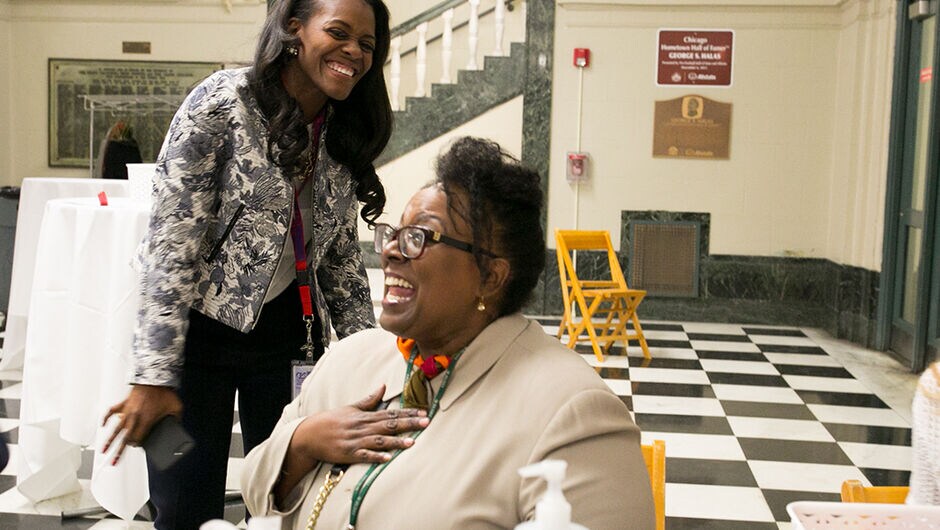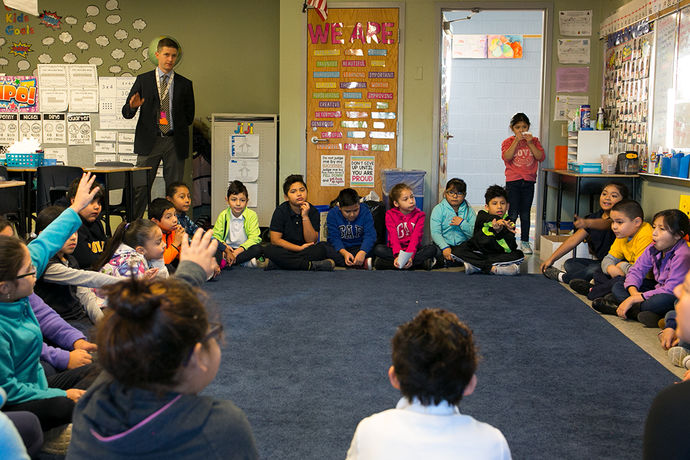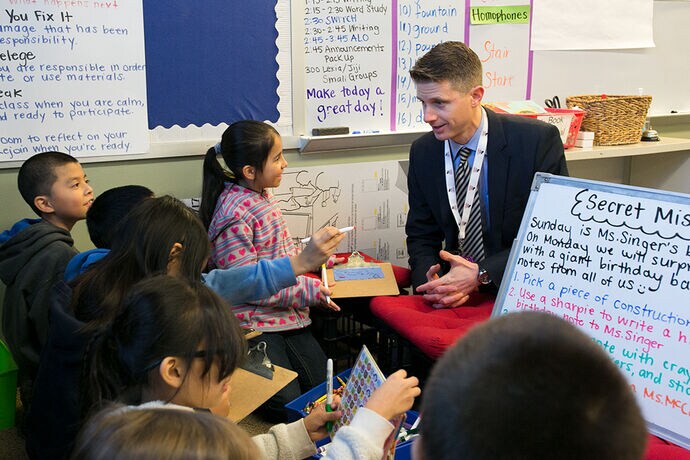
Freedom Leads to Results for Two District Principals in Chicago
Is Principal Autonomy Part of the Secret to Boosting Student Achievement?
Almost exactly 30 years ago, then-U.S. Secretary of Education William Bennett slammed Chicago’s public schools in casual comments to the press.
“There can’t be very many cities that are worse,” he said. He hit a nerve. A year later, the Illinois Legislature dramatically restructured Chicago schools by granting control to Local School Councils, elected bodies charged with hiring and firing principals and approving their decisions. In practice, the move granted principals far greater autonomy than they had enjoyed previously.
Then in 1990, a full decade before No Child Left Behind required school systems to collect and share troves of data, researchers at the University of Chicago formed a first-of-its-kind partnership with Chicago Public Schools and others, called the UChicago Consortium on School Research, to collect data, analyze it, and use it to drive improvements.
Today, the headlines tell a different story about Chicago schools. They are the fastest improving in the nation, according to a recent study by Stanford University researchers who crunched the numbers on millions of standardized tests nationwide. Graduation rates have been on the rise for nearly 20 years, up from a dismal 52 percent in 1998 to 75 percent in 2017 (the national average is 83 percent).
The UChicago Consortium reported that “between 2006 and 2015, attendance rates, average ACT composite scores, the number of students taking AP coursework, and the percentage of students scoring a 3 or higher on an AP exam all increased.”
The headlines are the result of investments and hard work on many fronts. But they come with caveats. Despite their growth, Chicago students still perform, on average, about a half grade behind their peers nationally. And not long after Chicago Mayor Rahm Emanuel celebrated 2017 graduation rates, Chicago City Wire published an analysis revealing enormous discrepancies between schools’ rates and the percentage of students who passed end-of-year PARCC exams, suggesting schools are graduating thousands of underprepared students. Still, the trend lines are undeniably up.
Heather Anichini (Chi–NWI ’02) directs the Chicago Public Education Fund, a nonprofit devoted to improving Chicago’s public schools by ensuring that outstanding principals lead them. Compared to other districts, most CPS principals have outsized influence over their schools because they have control over a large portion of their budgets, curricula, bell schedules, and many hiring decisions. Right now, about 200 of 664 district schools are making substantial gains year over year, Anichini says, citing the district’s accountability data. About 50 are chronically failing, and those in the middle could go either way. “Our theory,” she says, “is that the differentiator will be leadership.”
Anichini’s proposition is simple: Strong principals, given the flexibility to innovate, are more likely to stay in their jobs and improve Chicago’s schools. As schools improve, the whole system becomes healthier.
To see how two principals used their autonomy to turn around traditional district schools, One Day visited them at work. Barton Dassinger (R.G.V. ’98) is the principal at César E. Chávez Multicultural Academy, a pre-K-8 neighborhood school on Chicago’s south side. Fareeda Shabazz (Chi–NWI ’03) leads Crane Medical Preparatory High School, a non-selective magnet school on the city’s west side.
Fareeda Shabazz and Crane
On a recent Thursday, Crane Principal Fareeda Shabazz and Sharon Gates traded ideas at a rapid-fire pace across a café table at Rush University Medical Center, overlooking the L tracks and Chicago’s skyline. Gates is Shabazz’s liaison at Rush, one of the top teaching hospitals in the country. She connects Crane students with a steady stream of volunteer mentors, internship opportunities, and adjunct instructors. Could they design a course on healthcare IT? Or put students together with Rush staff members at the Cook County jail to do a service learning project on mental health?
In 2011, district officials slated Crane for closure. The school’s Greek Revival façade looked much the same as when it was built in 1903, but inside, results had crumbled. Fewer than half the students graduated. Juniors posted an average ACT score of 14, compared to a national average of 21.1. But supporters rallied to the school’s defense and district leaders decided to restart Crane in 2013 as a medical sciences magnet. A task force hired Shabazz as principal and gave her a year to build the program and hire teachers.

Today, Shabazz is in her fifth year at Crane, where students take mandatory classes in biomedical sciences and electives including community health and genetics. As early as freshmen year, Crane students can earn college credits (two freshmen took and passed college exams last year). By their junior and senior years, they can earn certifications at nearby Malcolm X College as phlebotomists and respiratory aides.
Shabazz has hired teachers like Phillip Yang (Chi–NWI ’16), who studied neuroscience at Stanford University. Yang is part of a district pilot group teaching a new biology curriculum, through which students investigate concepts like photosynthesis and cellular respiration by collecting real-life data sets. Science teacher Elizabeth Heckinger designed prosthetic limbs before becoming an educator. She teaches modeling to juniors and seniors using the classroom’s 3-D printer.
Crane sits in the western shadow of Chicago’s skyline, where it anchors a disappearing neighborhood. Beginning in the 1990s, wrecking balls felled nearby housing projects that were once home to thousands of students, making way for gentrification. Crane’s 2,200-student capacity is far greater than the neighborhood demands, so now it draws students from anywhere in the city. The majority, however, arrive each morning from the city’s south and west sides. Nearly all are students of color, and 89 percent come from low-income backgrounds.
Under Shabazz, academic outcomes have steadily improved. In 2016-17, more than 88 percent of students who started as freshmen graduated as seniors, and the average ACT score rose more than four points to 18.4. More than 40 percent of the school’s graduates had earned credits toward college or career certification.

But improving the education students receive isn’t enough to offset the district’s enrollment challenges—not if a school’s reputation doesn’t advance at the same pace. Enrollment in Chicago Public Schools has declined precipitously in recent years, in part the result of changing immigration patterns and an exodus of families impacted by crime and gun violence. In 2013, the district closed 50 elementary schools in a politically explosive attempt to right-size the system. Since then, 32,000 more students have left the district, according to an analysis by WBEZ, Chicago’s public radio affiliate. Today, more than 300 of the city’s 650 schools are under-enrolled, according to the same analysis. At more than 100 schools, at least half of the desks sit unfilled.
Eighth graders can apply to any high school in the city. Schools receive about $5,300 per enrolled student to support the cost of education. As a result, empty desks translate to smaller budgets. The most desirable schools have waiting lists and offer a wide array of electives and extracurricular programs, while the least desirable enroll students at a small fraction of the school’s capacity and can barely staff core courses.
Like dozens of high school principals, Shabazz has struggled to recruit students in such a competitive environment. “Options aren’t a bad thing,” she says, but adds that when there are so many more seats than students, principals face a steep marketing challenge. Of the 2,200 eighth graders who applied to Crane, only 77 enrolled as freshmen this year—about half the size of each of the older grades. Shabazz says she and her team relaxed recruitment efforts last year and learned their lesson. Still, because funding follows students, the decline led to a budget shortfall of about $325,000.
Because she had autonomy, Shabazz could choose how to mitigate damages. She didn’t refill the positions of three teachers who moved out of state. She cut one art teacher and one staff member. What mattered most to her was that she didn’t have to fight the district to stick with her vision of preparing students to enter some of the nation’s fastest-growing career fields. “That’s what would push me out of this job,” she says.

When Shabazz attended Howard University, she had planned to pursue pre-medicine until she earned a C in organic chemistry and changed her major. “I thought you needed to get all As to be a doctor,” she says. “I didn’t have a network of support to pursue pre-med.” Crane students are already building those networks, she says. She dreams of walking into a hospital like Rush and seeing a student employed there. “I can’t wait to say, ‘This is one of my babies.’”
Barton Dassinger and Chávez
César E. Chávez Multicultural Academy spreads out across three buildings tucked into the neighborhood called Back of the Yards, named for its proximity to the stockyards that once housed the city’s meatpacking industry. Parents corral their elementary-aged students into an angular, 1990s-era school building within a half mile of where most of them live. Preschoolers overflow into another building further west. Middle school students shuffle through the narrow doorways of a red brick schoolhouse a half block and a parking lot away from the elementary school, leased from the city’s Catholic archdiocese.
Last fall, Barton Dassinger, Chávez’s principal since 2010, got to wondering what made some of his middle schoolers thrive while others began to fade away. Over beer with a friend, he developed an experiment. Each student would be asked to list his or her three best friends. If the student attended school on the day before winter break and the first day back, he or she would be entered into a drawing for lunch with the friends and Dassinger at a local taqueria.

For the kids, it was a shot at free tacos. For Dassinger, analyzing the “friends” lists provided the data to begin to decode the inscrutable middle school social network. “The correlations were pretty remarkable,” he says. Students who were named most often by other students as friends had the highest GPAs, the best attendance, and the top standardized test scores. The opposite outcomes held true for students whom no one listed as friends. Dassinger presented the results at a CPS principals conference. His team now uses the “friends” data to inform how they shape the school experience, from forming tutoring groups to assigning lockers.
In the seven years since Dassinger became principal, Chávez has become a hub for the community, offering classes and programs after school until 7:30 p.m. and on Saturdays. It has also become one of the top-performing schools in the city. On the standardized Measure of Academic Progress (MAP) exams in 2017, Chávez students outperformed 92 percent of participating schools nationwide in math and 76 percent of schools in reading. Nearly half the 966 students are English language learners, and 99 percent qualify for free or reduced-price meals.
In 2010, one Chávez eighth grader earned a spot at one of the city’s five selective enrollment high schools. In 2017, 25 students did, including 10 who matriculated to Walter Payton College Prep, often cited as the best public high school in Illinois. Only two middle schools in Chicago sent more students to Payton, and unlike Chávez, both had selective enrollment policies.
Dassinger’s turnaround is, in part, testament to the power of a well-used spreadsheet. He tracks everything, the more granular the better. If a staff member wanted to know the attendance patterns over time of all English language learners who scored at the 50th percentile on standardized math exams, he’d have it in seconds. If it mattered whether the cafeteria served pizza on a given day, he’d find that too. And because the district grants principals decision-making power in budgeting, curricula, and scheduling, he can use the school-level data he collects to shape his school into what students need.
One example: In 2010, Chávez was a part of a CPS pilot program to extend the school day by one hour. Dassinger saw from the data that students got a big boost from the extra hour with their teachers, but the district discontinued the pilot, citing overall meager results. The following year, Dassinger spent about $300,000 to have a district-approved after-school organization run a similar program, but this time, the gains failed to materialize.

“That was one of my mistakes with autonomy, but it also allowed us to make lemonade out of lemons,” he says. Instead of working with an outside partner, he shuffled his budget to pay teachers their union-contracted salary for one additional hour each day. So at a cost of $200,000, students get an extra hour of instruction, and Dassinger uses higher teacher pay—about $6,000 more per year—as a recruitment tool. (The money comes in part from his overall decision only to hire teachers who directly oversee a classroom—meaning no instructional coaches, for example.)
For every Chávez student, Dassinger has a row on a spreadsheet tracking GPA, attendance, standardized test results, and special education and ELL status for all their years at the school. He uses the data in myriad ways, including as a guide when each seventh grader has his or her high school planning meeting. (Although students apply to high school as eighth graders, decisions are based on seventh grade scores.) Students, parents, and teachers are able to see exactly what their student has done and needs to do to get into the high school of their choice.
Using grant money from the nonprofit Next Generation Learning Challenges fund, Dassinger hired a full-time developer to turn this process into an app for students and parents citywide (Chávez students are using a beta version). Students will plug in academic data and test scores from their report cards. Then, just like a mortgage calculator produces a range of home prices based on financial data, the app will produce high school options, helping students set academic goals leading up to eighth grade.
Dassinger’s meticulous planning hasn’t always saved him trouble. When the district ran out of money last winter, for the second year in a row, it reclaimed funds that schools had saved to cover programs for the remainder of the year. Dassinger had saved more than most principals, to cover Chávez’s extra hour of school. (Around that time, the Chicago Sun-Times published an article showing that schools that serve students of color and from low-income backgrounds were disproportionately impacted by the district’s financial crisis.) Dassinger petitioned Next Generation Learning Challenges to use about $100,000 in unspent grant money to continue the extended day.
Still, he’s grateful for his freedoms. “No one tells us what textbooks to use, or what teachers to hire, or how to schedule the school day,” he says. “We’re allowed to be creative here in a way that doesn’t happen in most districts.”
Sign up to receive articles like this in your inbox!
Thanks for signing up!
Content is loading...


